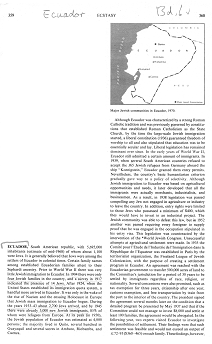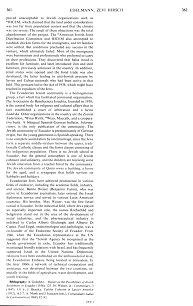<
ECUADOR,
South American republic, with 5,695,000 inhabitants
(estimate of mid-1968) of whom about 1,000 were Jews. It is
generally believed that Jews were among the settlers of
Ecuador in colonial times. Certain family names among
established Ecuadorian families attest to their Sephardi
ancestry.
[Jewish population figures]
Prior to World War II there was very little Jewish
immigration to Ecuador. In 1904 there were only four Jewish
families in the country, and a survey in 1917 indicated the
presence of 14 Jews.
After 1924, when the United States established its
immigration quota system, a handful more arrived in Ecuador.
It was only in the wake of the rise of Nazism and the
ensuing Holocaust in Europe that Jewish mass immigration to
Ecuador began. During the years 1933-43 about 2,700 Jews
arrived, and by 1945 there were already 3,000 new Jewish
immigrants, 85% of whom were refugees from Europe.
At its peak (in 1950), the Jewish population of Ecuador was
estimated at 4,000 persons; the majority lived in Quito,
several hundred in Guayaquil and several scores in Ambato,
Riobamba, and Cuenca. (col. 359)
Table. Jews
in Ecuador 1917-1950
|
Year
|
number
|
1917
|
14
|
1924
|
a handful more
|
1933-1943
|
+ about 2,700
|
1945
|
3,000 immigrants
|
1950
|
4,000 (the peak)
|
since 1950
|
sinking numbers
|
Table by Michael Palomino; from: Ecuador;
In: Encyclopaedia Judaica 1971, vol. 6, col.
359-360
|
[1935-1936: Attempts for
agricultural settlements don't give enough profit]
[[...]]
Unsuccessful attempts at agricultural settlement were made.
In 1935 the Comité pour l'Etude de l'Industrie de
l'Immigration dans la République de l'Equateur [[Committee
for industry and immigration for the Republic of Ecuador]]
was established in Paris by the territorialist organization,
the Freeland League of Jewish Colonization, with the purpose
of creating a settlement program in Ecuador.
[[The natives who were expelled from their territories are
never mentioned in the article]].
An agreement was reached with the Ecuadorian government to
transfer 500,000 acres of land to the Committee's
jurisdiction for a period of 30 years to be settled by
immigrants regardless of race, religion, or nationality.
Several concessions were also promised, such as tax
exemption for three years, citizenship after one year,
customs exemption, and free transportation by train from the
port to the interior of the country.
The president signed the agreement several months later on
the condition that a detailed program be presented by May
1937 and that if the Committee could not manage to invest $
8,000 and settle at least 100 families, the agreement would
be abrogated. In the following year, two experts visited
Ecuador to investigate the possibilities of settlement.
Their findings were that such settlement was feasible and
would not exceed an output of £ 72-93 ($360-465) on each
family. These findings, however, (col. 360)
proved unacceptable to Jewish organizations such as *HICEM,
which claimed that the land under consideration was too far
from population centers and that the climate was too severe.
The result of these objections was the total abandonment of
the project.
The *American Jewish Joint Distribution Committee and HICEM
also attempted to establish chicken farms for the
immigrants, and 60 families were settled. But conditions
precluded any success in the venture, which ultimately
failed. (col. 361)
[[...]]
[1936: Liberal legislation
- 1938: restriction of immigration]
Although Ecuador was characterized by a strong Roman
Catholic tradition and was previously governed by
constitutions that established Roman Catholicism as the
State Church, by the time the large-scale Jewish immigration
started, a liberal constitution (1936) guaranteed freedom of
worship to all and also stipulated that education was to be
essentially secular and lay. (col. 360)
[[...]]
Nevertheless, the country's basic humanitarian criterion
gradually gave way to a policy of selectivity. Although
Jewish immigration to Ecuador was based on agricultural
opportunities and needs, it later developed that all the
immigrants were actually merchants, industrialists, and
businessmen. (col. 360)
[[...]]
Most of the immigrants were businessmen and professionals
who preferred to carry on their professions. They discovered
that balsa wood is excellent for furniture, and later
introduced iron and steel furniture, previously unknown in
the country. In addition retail stores were opened and the
hotel trade was also developed, the latter leading to
anti-Jewish pressure by Syrian and Cuban nationals who had
been active in that field. (col. 361)
[[...]]
As a result, in 1938 legislation was passed compelling any
Jew not engaged in agriculture or industry to leave the
country. In addition, entry rights were limited to those
Jews who possessed a minimum of $ 400, which they would have
to invest in an industrial project. The Jewish community was
able to defeat this law. (col. 361)
[[...]]
Liberal legislation has remained dominant ever since
(col. 360).
[1939: the case of the ship
"Koenigstein" (King's Stone)]
In the early years of World War II, Ecuador still admitted a
certain amount of immigrants. In 1939, when several South
American countries refused to accept the 165 Jewish refugees
from Germany aboard the ship "Koenigstein", Ecuador granted
them entry permits. (col. 360)
[[...]]
In 1952 another was passed requiring every foreigner to
supply proof that he was engaged in the occupation
stipulated in his entry visa. This legislation was
counteracted by the intervention of the *World Jewish
Congress. (col. 360)
[[...]]
[Community structure and
cultural life - special middle strata - no complete
intermarriage assimilation]
The Ecuadorian Jewish community is a homogeneous group, a
fact which has facilitated communal organization. The
Asociación de Beneficencia Israelita [[Israelite Relief
Association]], founded in 1938, is the central body for
religious and cultural affairs that in turn established a
court of arbitration and a
hevra kaddisha [[holy assembly]]. Other
organizations in the country are the Zionist Federation,
*B'nai B'rith, *Wizo, Maccabi, and a cooperative bank. A
bilingual Spanish-German bulletin,
Informaciones, is the only publication of
the community. The Jewish community of Ecuador is
predominantly of German origin, but the young generation is
Spanish-speaking. There is no complete assimilation by
intermarriage, since the Jews form a separate middle-Stratum
between the upper, traditionally Catholic classes and the
lower classes consisting of the indigenous population.
There is no Jewish school in Ecuador, but the general
atmosphere is one of Jewish cohesion and solidarity, and the
children are receiving some Jewish education from a teacher
hired by the community. The Jewish community of Quito owns a
building, a home for the aged, and a synagogue that holds
services on Sabbaths and holidays.
[Jewish personalities:
industrialization with metal industries and pharmaceutical
industries]
Ecuadorian Jews have achieved prominence in various fields
of endeavor, including the academic fields, industry, and
science. Benno Weiser (Benjamin Varon), who was active in
Ecuadorian journalism, later entered the Israel diplomatic
service and served in various Latin American countries. His
brother, Max Weiser, was the first Israel consul in Ecuador
[[of racist Zionist Israel]]. In the industrial field, where
Jews played an especially important role, the manes
Rothschild and Seligmann stand out in the area of the
development of metal industries, and the pharmaceutical
industry is indebted to Carlos Alberti Ottolenghi and
Alberto Di Capua. Paul Engel, endocrinologist and
pathologist, was a co-founder of the Endocrine Society of
Ecuador.
[Relations with racist
Zionist Free Mason CIA Herzl Israel - cooperation]
From 1946, when the Ecuadorian representative at the UN
suggested that the *Jewish Agency be recognized as the
Jewish government in exile, Ecuador has traditionally
maintained friendly relations with Israel, and has
frequently supported Israel in the United Nations.
Diplomatic relations have been established on the
ambassadorial level, the Ecuadorian Embassy being located in
Jerusalem.
In the later 1960s a network of technical cooperation and
assistance was developed between the two countries,
especially in the fields of agriculture, water development,
and youth training.
Bibliography
-- A. Golodetz: Report on the Possibilities of Jewish
Settlement in Ecuador (1936), 125-30
-- Weiser, in: Commentary, 3 (1947), 531-6
-- J. Shatzky: Yidishe Yishuvim in Latayn Amerike (1952),
162-7
-- A. Monk and J. Isaacson (eds.): Comunidades Judías de
Latinoamérica (1968), 82-83.
[P.E.]> (col. 361)




